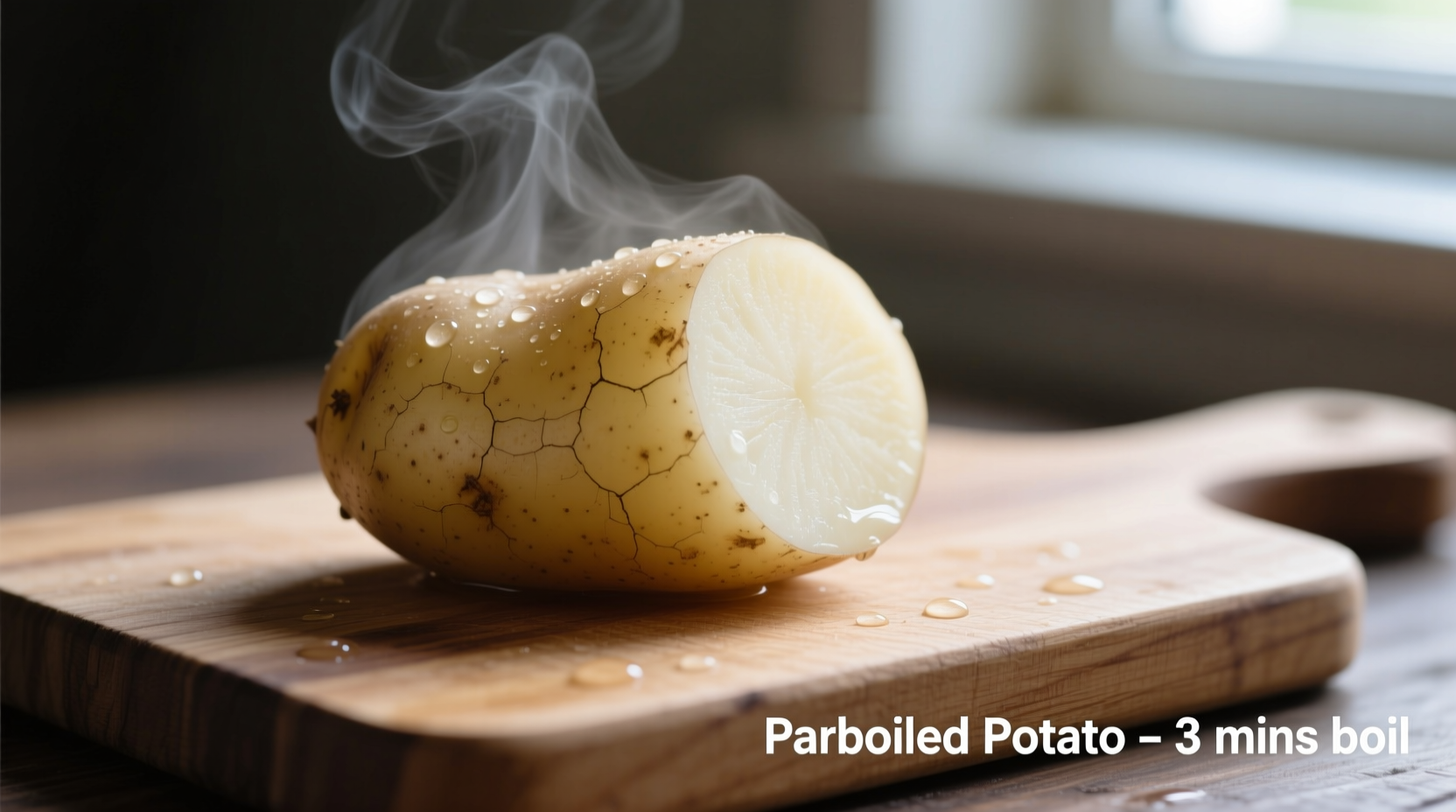Parboiled potatoes are partially cooked potatoes that have been briefly boiled then cooled, creating the perfect foundation for crispy roasted potatoes, better mashed potatoes, and improved texture in various dishes. This technique partially gelatinizes surface starch while maintaining structure, resulting in superior texture and cooking consistency.
The Secret to Perfectly Crispy Roasted Potatoes Every Time
Professional chefs have relied on parboiling potatoes for decades to achieve that coveted crispy exterior and fluffy interior. Unlike fully boiled potatoes, parboiled potatoes undergo a controlled partial cooking process that transforms their texture without compromising structural integrity. This simple technique makes a dramatic difference in your final dish, whether you're preparing classic roast potatoes, hash browns, or potato salads.

Why Parboiling Transforms Your Potato Dishes
When potatoes hit high heat directly, their exterior often burns before the interior cooks through. Parboiling solves this fundamental cooking challenge by giving potatoes a head start. The brief boiling period partially cooks the potato while creating microscopic fissures in the surface starch. These tiny cracks become the perfect foundation for crispiness when exposed to high heat.
| Property | Raw Potato | Parboiled Potato | Fully Boiled Potato |
|---|---|---|---|
| Surface Texture | Smooth, intact | Roughened, slightly broken | Very soft, fragile |
| Starch Behavior | Intact granules | Partially gelatinized | Completely gelatinized |
| Best For | French fries, chips | Roasting, grilling | Mashing, soups |
| Cooking Time Reduction | None | 30-40% less roasting time | N/A |
The Science Behind the Perfect Parboil
According to research from the USDA Agricultural Research Service, potatoes contain two key starch components: amylose and amylopectin. During parboiling, these starches begin to absorb water and swell at approximately 140°F (60°C), a process called gelatinization. The Oregon State University Extension Service confirms that partial gelatinization creates the ideal surface texture for crisping while maintaining structural integrity.
The critical window for parboiling occurs between 3-7 minutes, depending on potato variety and size. This precise timing allows surface starches to begin breaking down without the potato becoming too soft. Over-parboiling leads to disintegration during roasting, while under-parboiling fails to create the necessary surface texture for optimal crisping.
Step-by-Step Parboiling Guide for Perfect Results
Follow this professional technique for consistently excellent parboiled potatoes:
- Choose the right potatoes: Waxy varieties like Yukon Gold or red potatoes hold their shape better than starchy Russets for most parboiling applications
- Prep properly: Cut uniform pieces (1.5-2 inches) for even cooking; smaller pieces need less time
- Cold start: Place potatoes in cold, salted water (1 tablespoon salt per quart)
- Controlled boil: Bring to gentle simmer (not rolling boil) and cook for precise time
- Shock immediately: Drain and plunge into ice water for 2 minutes to stop cooking
- Dry thoroughly: Pat completely dry with clean towels before roasting or further cooking
Timing Guide for Different Potato Varieties
Adjust parboiling time based on your potato type and cut size:
- Small cubes (1 inch): 3-4 minutes for waxy potatoes, 4-5 minutes for starchy varieties
- Medium chunks (1.5 inches): 5-6 minutes for waxy, 6-7 minutes for starchy
- Whole baby potatoes: 7-8 minutes regardless of variety
The USDA Food Safety and Inspection Service recommends parboiling potatoes to 165°F internal temperature for food safety when preparing dishes that won't reach this temperature during final cooking.
Avoid These Common Parboiling Mistakes
Even experienced cooks make these critical errors that compromise results:
- Skipping the ice bath: Without shocking, residual heat continues cooking potatoes, leading to mushiness
- Insufficient drying: Moisture prevents proper crisping during roasting
- Overcrowding the pot: Causes uneven cooking and inconsistent results
- Using boiling water: Starting in boiling water creates uneven cooking with mushy exteriors
Maximizing Your Parboiled Potatoes
After parboiling, enhance your potatoes with these professional techniques:
- Rough up the edges: Shake parboiled potatoes in a colander to create extra surface area for crispiness
- Preheat your fat: Always add potatoes to hot oil or fat for immediate sizzling
- Space properly: Arrange with space between pieces on the baking sheet
- Season after parboiling: Salt before roasting, not during boiling, for better texture
Storage Guidelines for Parboiled Potatoes
Proper storage maintains quality when preparing in advance:
- Refrigeration: Store in airtight container for up to 24 hours
- Freezing: Parboiled potatoes freeze well for up to 3 months (best when slightly under-parboiled)
- Never store in water: Causes waterlogging and texture degradation
- Refrigerate within 2 hours: Follow food safety guidelines to prevent bacterial growth
Ideal Applications for Parboiled Potatoes
While parboiling benefits many dishes, it's particularly essential for:
- Roasted potatoes: Creates dramatically crispier exterior with fluffy interior
- Potato salads: Ensures even cooking without mushy texture
- Breakfast potatoes: Achieves perfect crisp-tender texture for hash browns
- Casseroles: Prevents undercooked centers in layered dishes
- Grilled potatoes: Reduces grill time while ensuring thorough cooking
When Parboiling Isn't Necessary
Understanding context boundaries helps you use this technique effectively. Parboiling provides minimal benefit for:
- Mashed potatoes (fully boiling is more appropriate)
- Potato soups and stews (potatoes will fully cook in liquid)
- French fries (double-frying technique replaces parboiling)
- Very thin potato slices for gratins
As noted by culinary researchers at Cooking Science Guy, parboiling shines when you need to finish cooking with dry heat methods while maintaining structural integrity—a perfect solution for roast potatoes and similar applications.
Perfect Parboiled Potato Roast Recipe
Apply your new knowledge with this simple professional method:
- Parboil 2 lbs Yukon Gold potatoes (cut into 1.5-inch chunks) for 6 minutes
- Shock in ice water, then thoroughly dry
- Roughen edges by shaking in colander
- Heat 3 tablespoons duck fat in roasting pan at 425°F (220°C)
- Add potatoes, rosemary sprigs, and garlic cloves
- Roast 40-45 minutes, flipping once, until golden and crisp
This method consistently produces restaurant-quality results with maximum crispiness and minimal effort.











 浙公网安备
33010002000092号
浙公网安备
33010002000092号 浙B2-20120091-4
浙B2-20120091-4